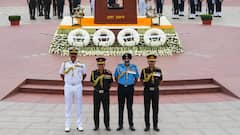Opinion: Are Indian Hospitals Ready For The Next Disaster? Recent Tragedies, From Fire To Floods, Expose Sad Reality
Even at top government hospitals, disaster management plans (DMPs) often exist only on paper and are rarely implemented effectively.

By Dr Eilia Jafar
Disaster preparedness in Indian hospitals is a critical concern, especially given the increasing frequency of natural disasters and public health emergencies. Hospitals play an important role as the first point of care during emergencies, but many remain vulnerable and ill-equipped to handle large-scale crises. Even at top government hospitals, disaster management plans (DMPs) often exist only on paper and are rarely implemented effectively.
There are examples aplenty that show how this unpreparedness of hospitals results in tragedy. In May this year, a tragic fire incident at Baby Care Newborn Hospital in Delhi's Vivek Vihar area claimed the lives of eight newborns, exposing the severe gap between planning and actual readiness.
During the 2023 Delhi floods, when low-lying areas were severely inundated, over 40 patients of Sushrut Trauma Centre had to be urgently relocated to Delhi’s LNJP Hospital as water flooded the former. In 2022, a fire at New Life Multispecialty Hospital in Jabalpur led to the death of eight patients, while severe flooding in Assam the same year forced a 150-bed cancer hospital to administer chemotherapy on the streets due to waterlogging at the facility. In 2021, a fire in the ICU of Ahmednagar Civil Hospital resulted in the loss of 11 lives, while a blaze at the Bhandara District General Hospital in Maharashtra killed 10 newborns the same year.
These incidents reflect the critical deficiencies in the country's healthcare facilities, which begs the question: Are we waiting for more disasters before taking real action?
Critical Facets Overlooked
Besides immediate damage to infrastructure, disasters can disrupt public services and cause excessive strain on the health system. Moreover, patients and healthcare providers go through trauma that may lead to a chain of difficulties that extend beyond physical injuries.
The concept of a business continuity plan for health facilities is critical but often overlooked. These plans must encompass not only structural safety but also non-structural elements, which are equally crucial. Unfortunately, most health facilities in India lack the structural integrity necessary to withstand disasters. This raises concerns about the effectiveness of disaster management in hospitals, which may be limited to mere documents if the physical structure fails.
Even in cases where the building remains intact, damage to non-structural elements — such as operation theatres — can halt critical procedures. The lack of proper site selection when constructing hospital buildings further compounds the problem. Many hospitals are built without considering the natural-hazard risks specific to their location, leading to structures that are ill-equipped to handle such incidents.
A study conducted in Delhi between 2016 and 2017 highlighted a worrying trend: the perception of structural safety among hospital staff and visitors is often based on the external appearance of a building rather than on rigorous assessments. This superficial understanding underscores the urgent need for comprehensive assessment of structural safety across all hospitals.
Non-structural safety measures, often neglected, play a significant role in disaster preparedness. Many injuries sustained during earthquakes and fires are due to non-structural elements such as false ceilings and unanchored furniture. In earthquake-prone areas, hospitals may become non-functional in the immediate aftermath of a temblor because of fallen objects that block evacuation routes and hinder movement. External elements, like unsecured water tanks and air conditioning units, pose additional risks. Some hospitals, like the National Institute of TB and Respiratory Diseases and Lal Bahadur Shastri Hospital in Delhi, have taken steps to secure these elements, but such measures are not yet a standard practice.
The lack of uniformity in emergency codes used by hospitals further adds to the confusion during disasters. When codes vary from one hospital to another, it creates unnecessary challenges for visitors and emergency staff, complicating response efforts.
Mitigation Measures Needed
The use of technology in hospitals seems to be increasing and this comes with its own sets of issues like data security. In most of the hospitals, data backup is kept on the same premises. Although there are guidelines for hospital disaster management planning from the National Disaster Management Authority, efforts are required to ensure implementation. While several hospitals have documented plans, most forget essential elements such as fuel and equipment backup, especially those with more than 100 beds. For example, some facilities might have power backup but not enough fuel supply to run continuously for a given period particularly during outages.
There are internationally tested mitigation measures that India could adopt to improve disaster preparedness in hospitals. Installing automated flood gates in hospitals located in low-lying, flood-prone areas, using hydrological sensors for early flood warnings, and setting up sensor-fitted pumping stations to drain floodwater from critical areas are all practical solutions. In coastal regions, aerodynamic building designs with cyclone-resistant glass and roofs could reduce the impact of storms. Additionally, storm surge barriers could offer protection against coastal flooding.
Power failures pose a significant risk to hospital operations, particularly for life-support systems. Microgrids, capable of operating independently of the main power grid, could provide a reliable backup in the event of damage to power infrastructure.
India’s hospitals should be fortified against the ever-present risk of disasters. The country’s healthcare infrastructure needs to go beyond merely fulfilling regulatory requirements and move towards implementing robust, practical measures that can withstand the challenges posed by both natural and human-made disasters. Only then can we ensure the safety of both patients and healthcare workers, and maintain the integrity of our health system during crises.
The writer is a humanitarian and development professional.
[Disclaimer: The opinions, beliefs, and views expressed by the various authors and forum participants on this website are personal and do not reflect the opinions, beliefs, and views of ABP News Network Pvt Ltd.]
Check out below Health Tools-
Calculate Your Body Mass Index ( BMI )
Calculate The Age Through Age Calculator





































